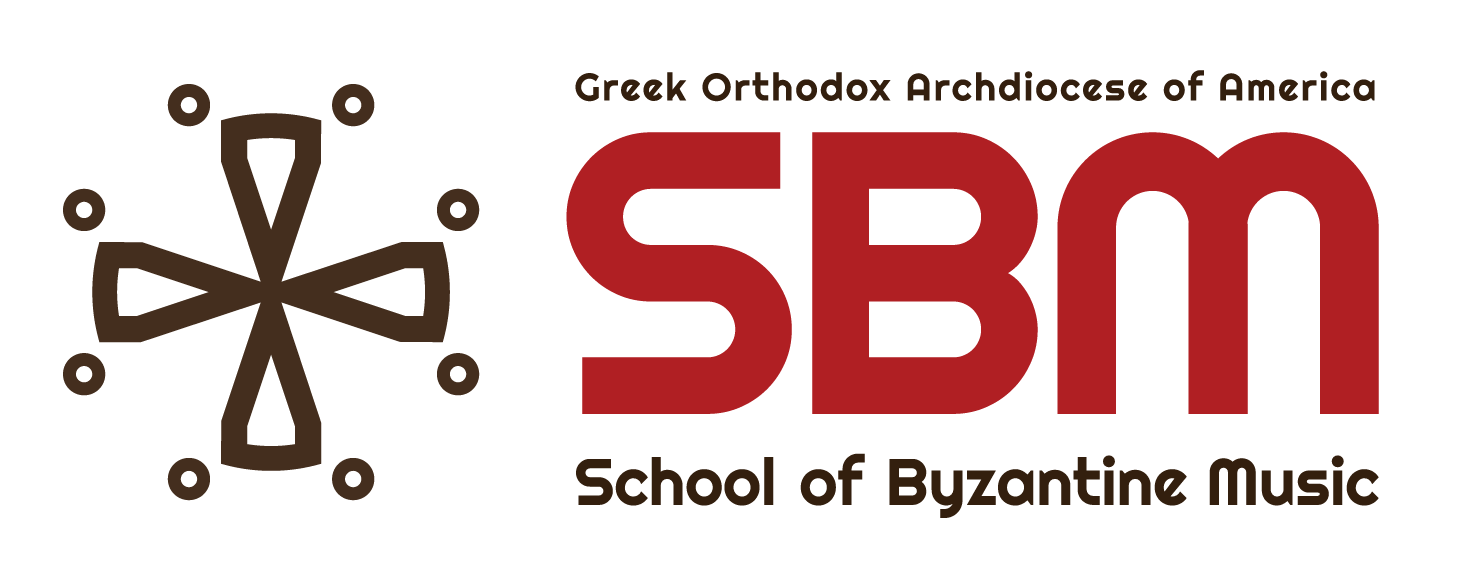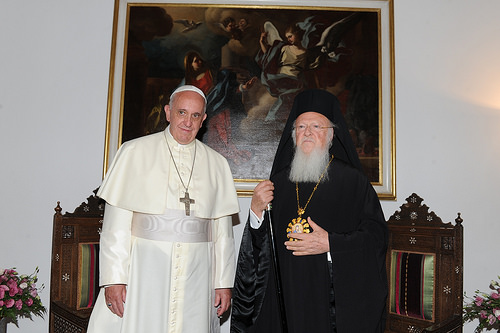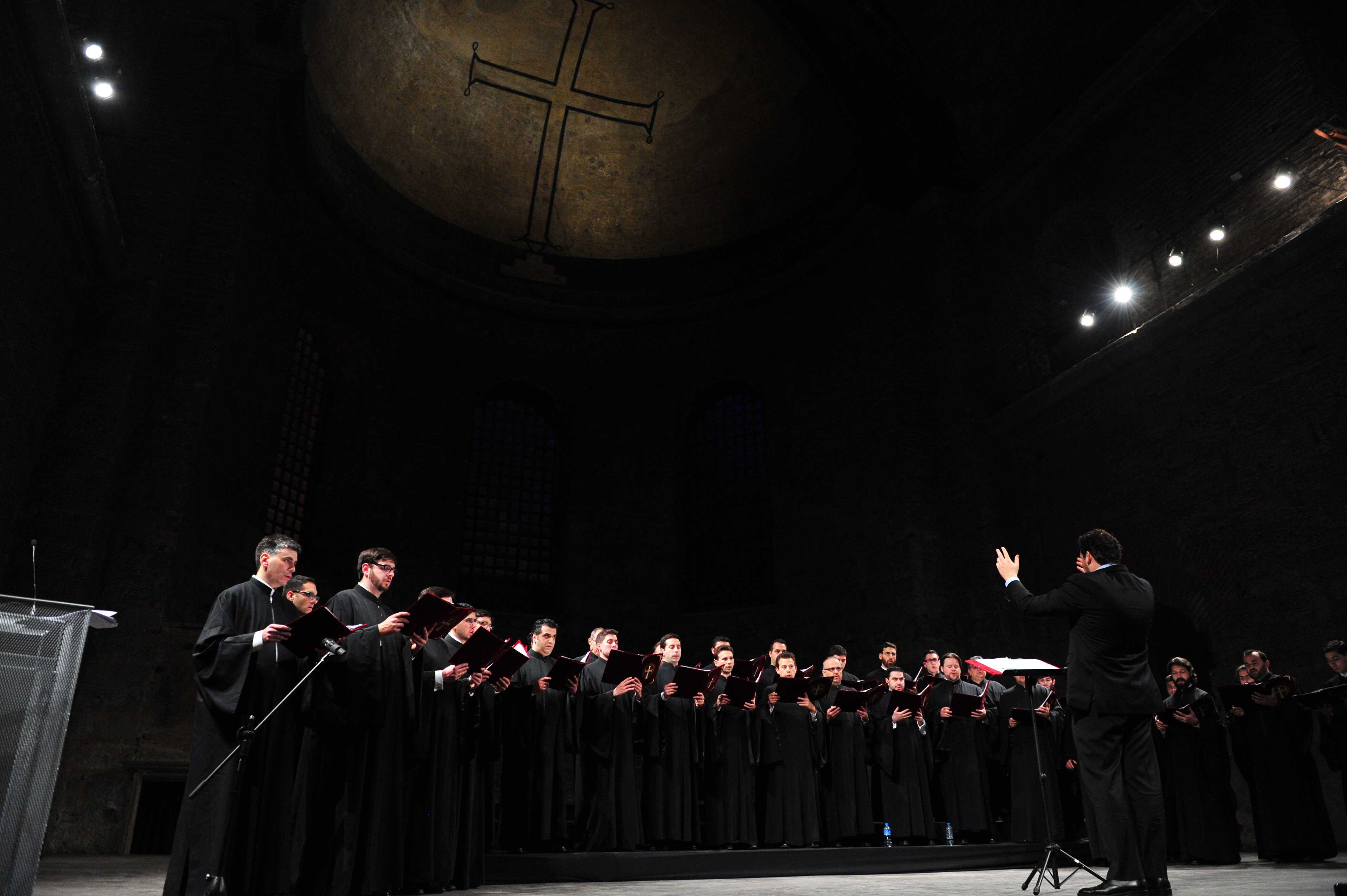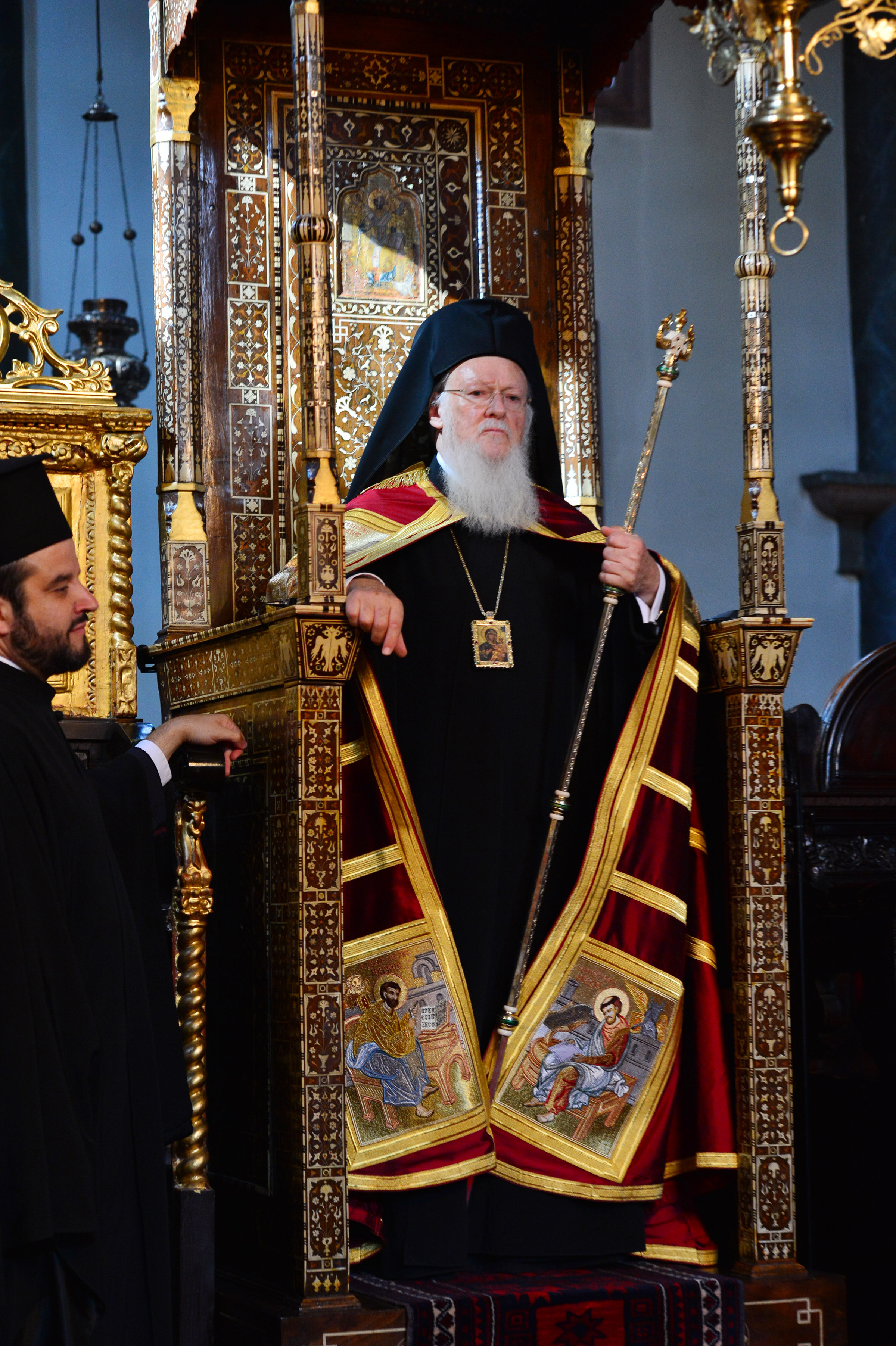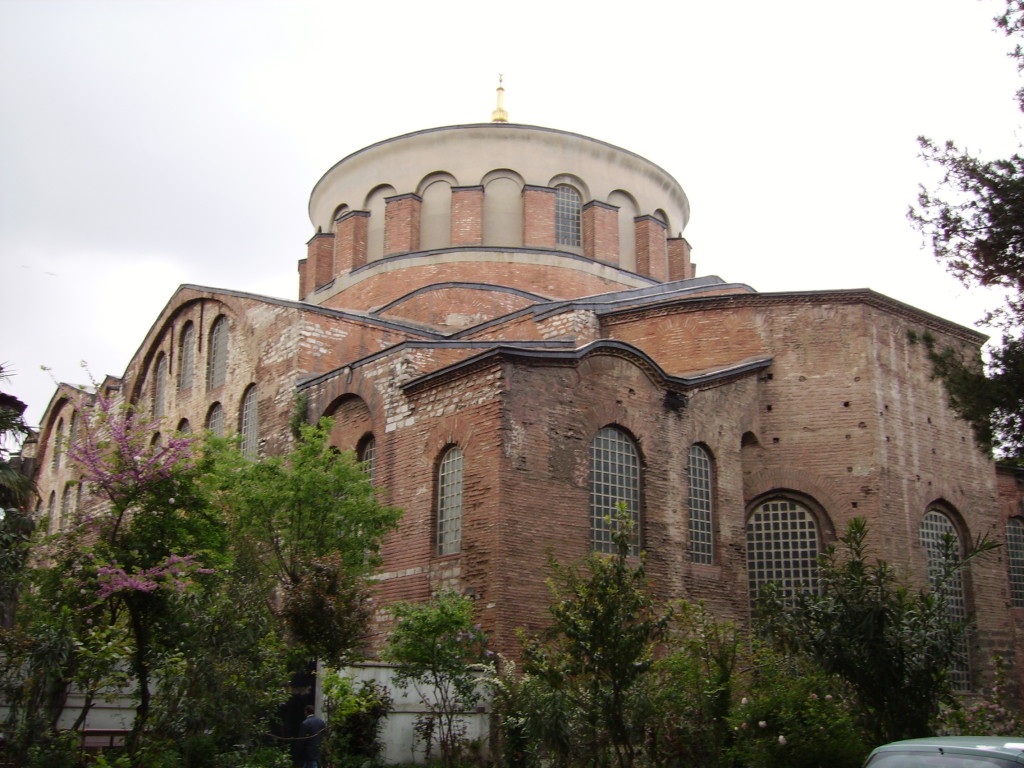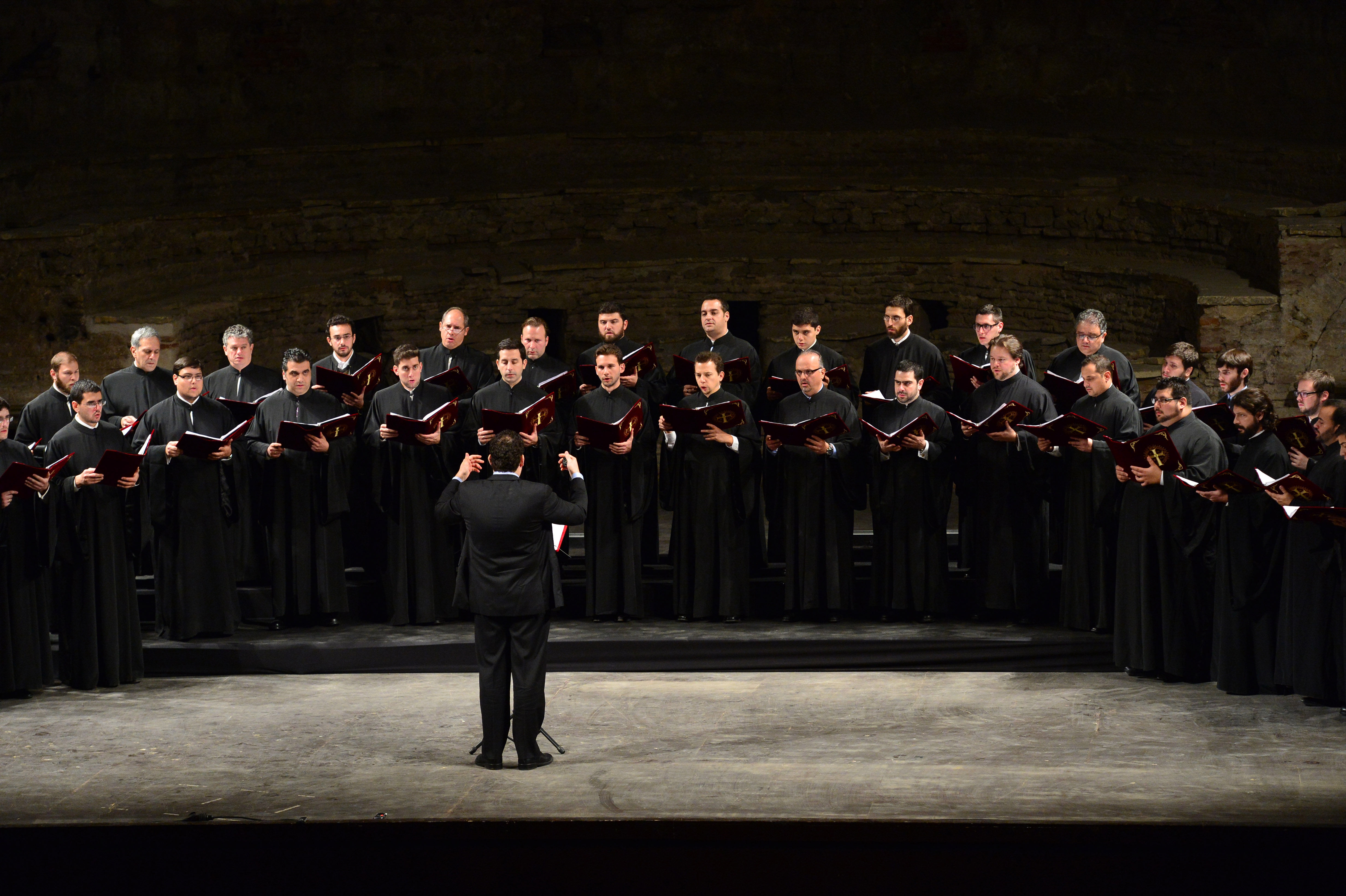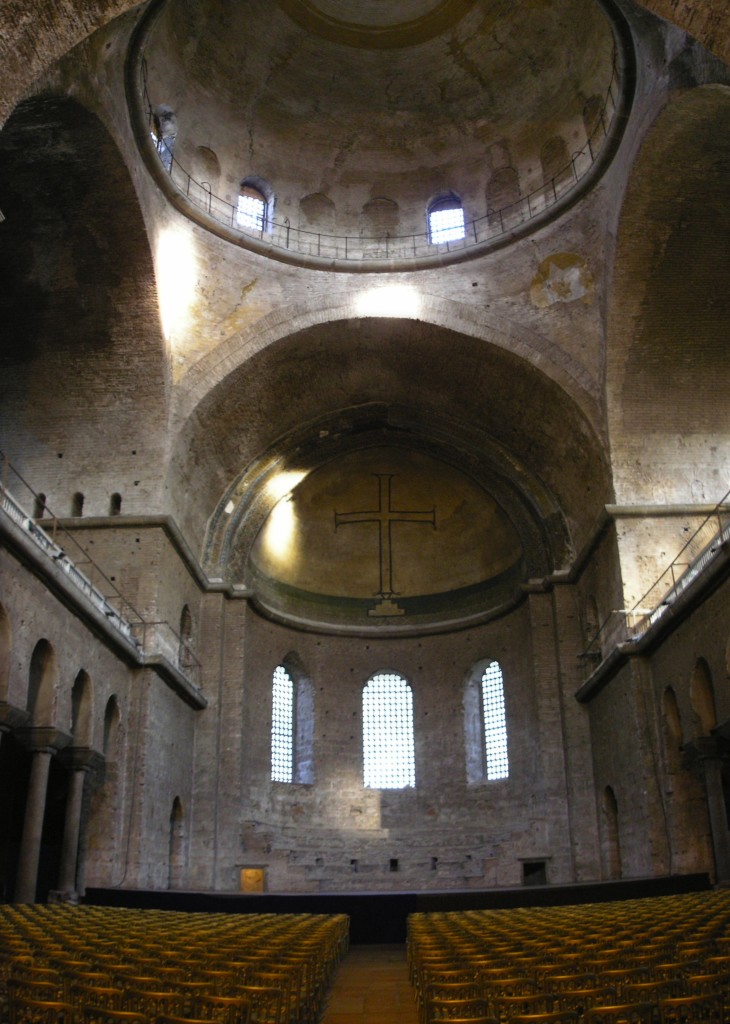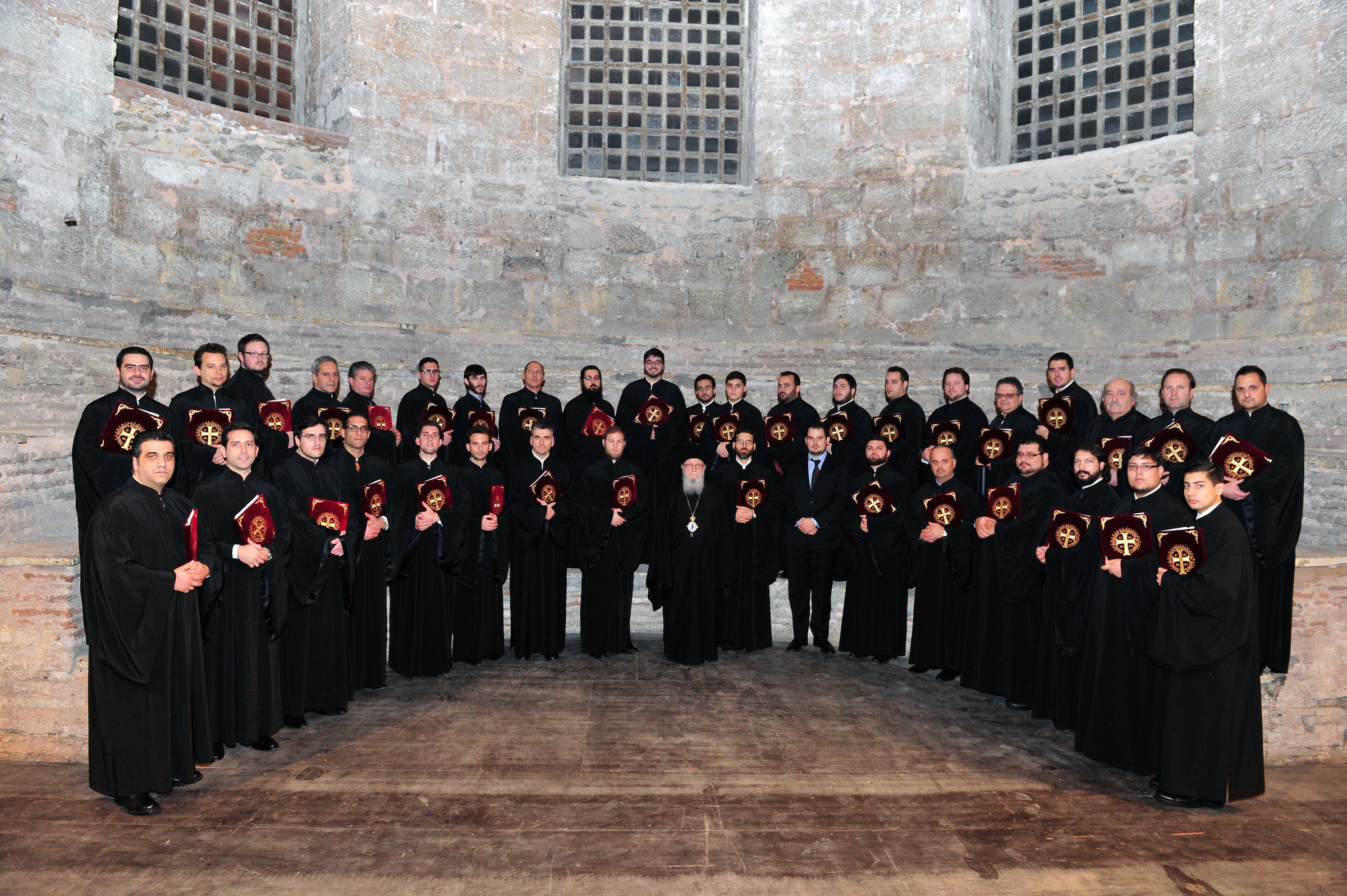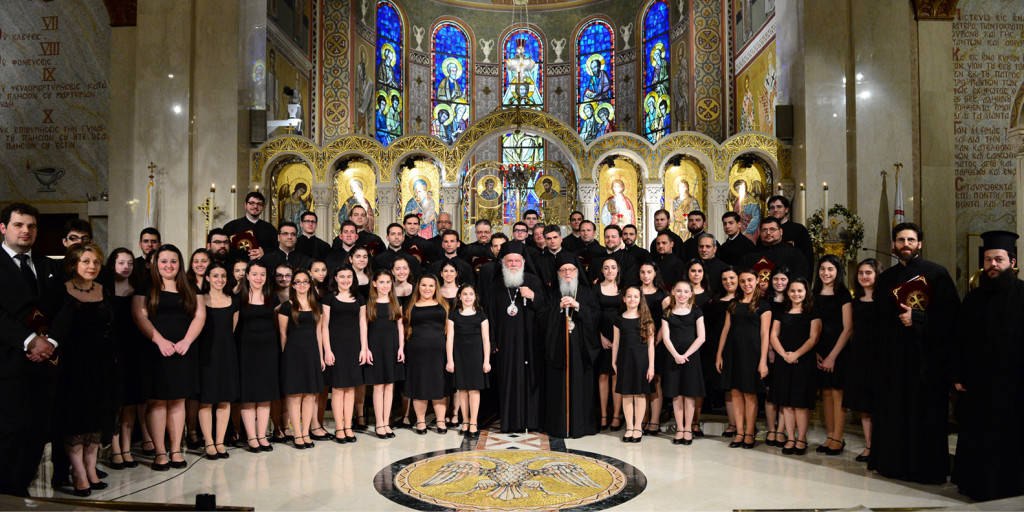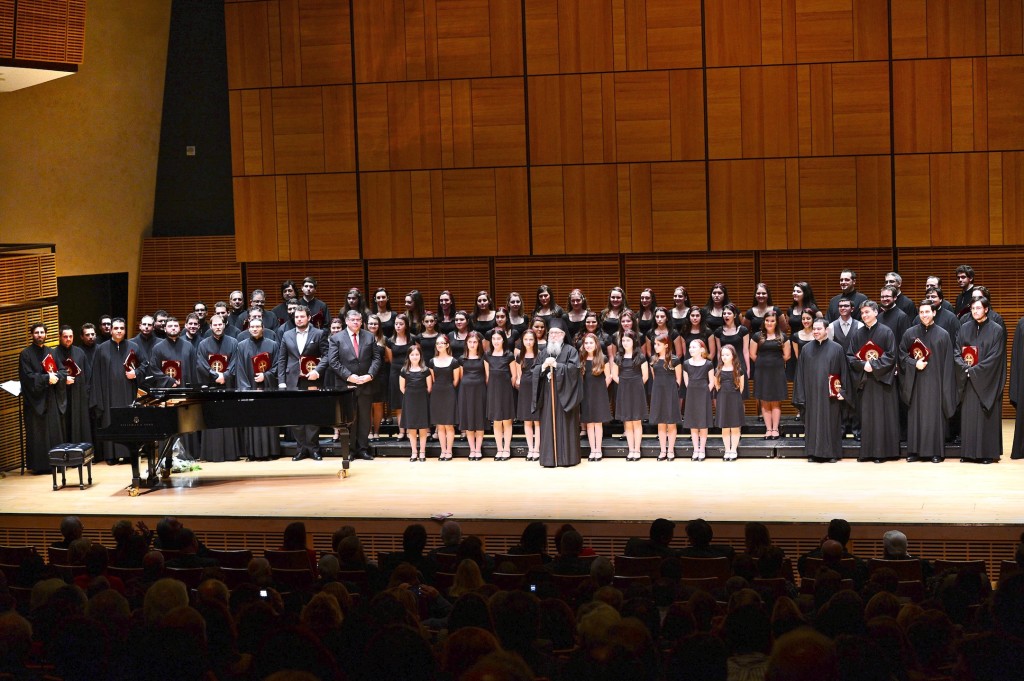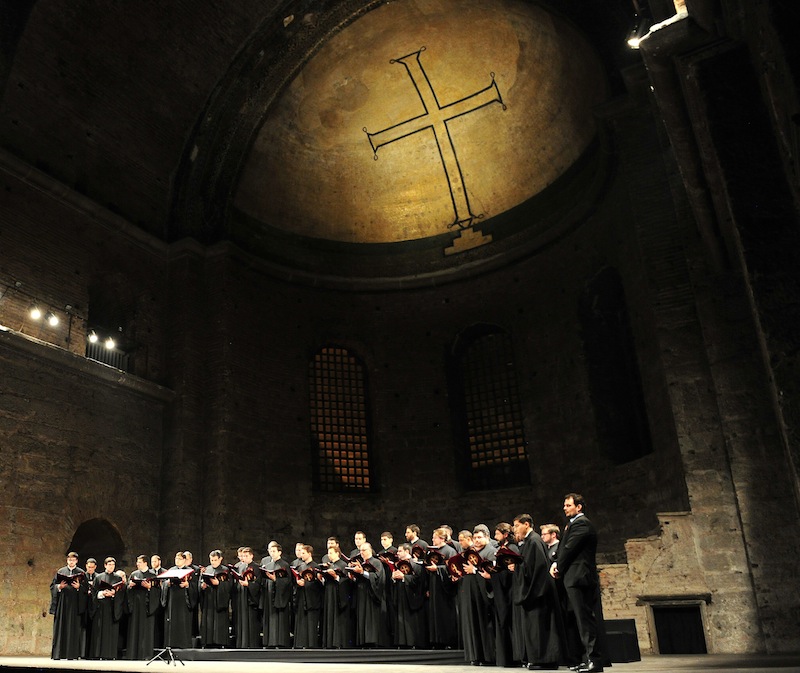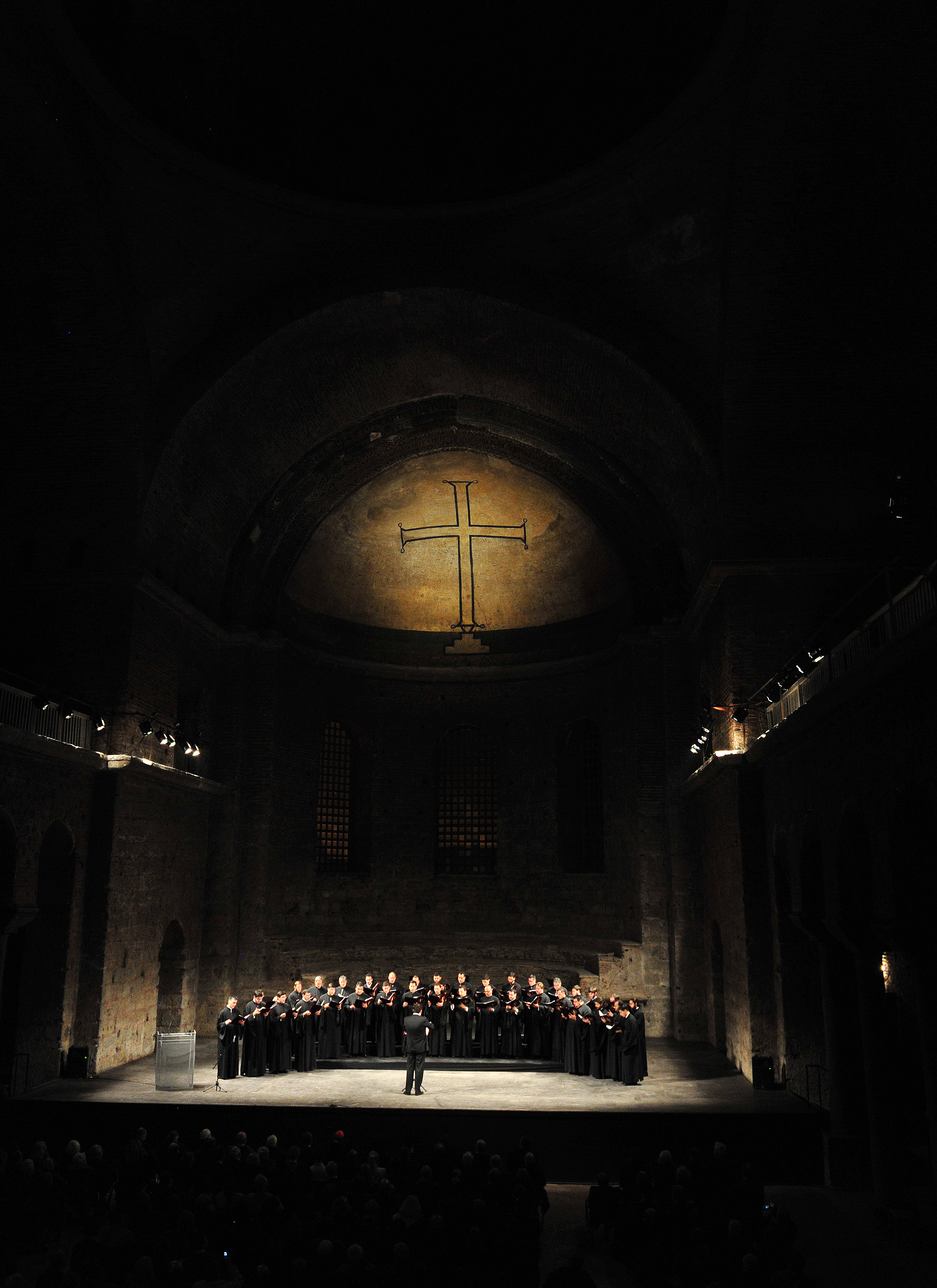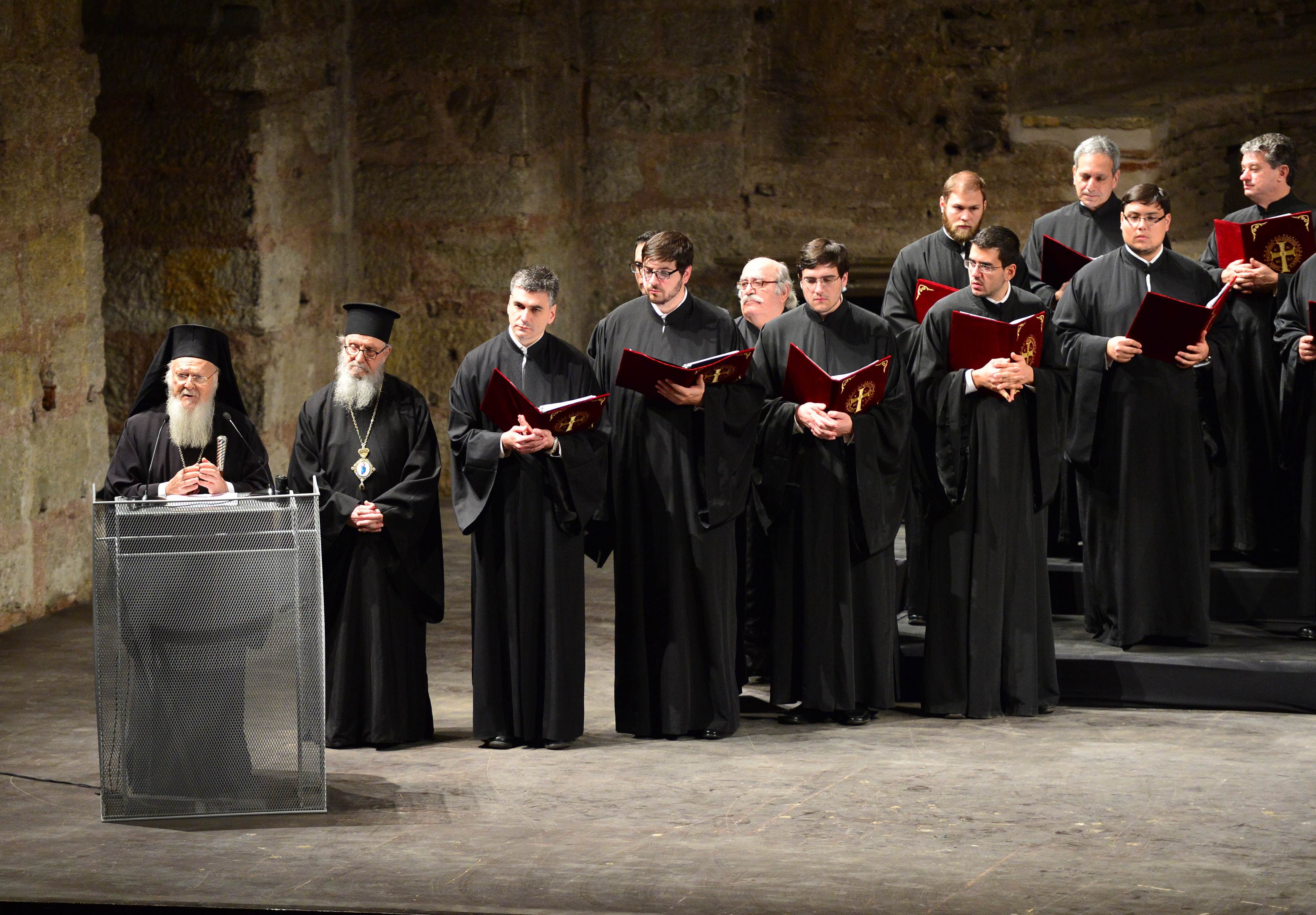[pl_tabs][pl_tabtitlesection type=”tabs”][pl_tabtitle active=”yes” number=”1″]The Concert[/pl_tabtitle][pl_tabtitle number=”2″]Ecumenical Patriarchate[/pl_tabtitle][pl_tabtitle number=”3″]Hagia Irini[/pl_tabtitle][pl_tabtitle number=”4″] Our Choir[/pl_tabtitle][pl_tabtitle number=”5″]Sponsorship[/pl_tabtitle][/pl_tabtitlesection]
[pl_tabcontentsection][pl_tabcontent active=”yes” number=”1″]
All Photos by D. Panagos
HISTORIC MEETING
BETWEEN POPE FRANCIS AND ECUMENICAL PATRIARCH BARTHOLOMEW
The Archdiocesan Byzantine Choir of the Greek Orthodox Archdiocese of America was founded in 2010 with the blessing of His Eminence Archbishop Demetrios of America to promote and share the sacred art of Byzantine music throughout the Archdiocese and beyond. However, this year will be marked in a special way for our choir. For the first time, we will witness the historic meeting between Pope Francis and Ecumenical Patriarch Bartholomew in Constantinople during the great feast of St. Andrew, the First-Called Apostle on November 29-30, 2014. Our choir has been bestowed the great privilege to seal this historic meeting with a concert in honor of these two modern Apostolic Peacemakers. In order to make this historic event possible and help us realize our dream, we need your help!
This year we chose to fundraise by producing an COMMEMORATIVE ALBUM which will be published at the conclusion of the trip. Because we honor and respect the support that you will give us as we make preparations for this historic concert, and also feel an obligation to give back to all of our supporters, the vision for this album is that it will contain pictures and highlights from the festivities taking place in Constantinople, as well as pages which will highlight YOU, our supporters and benefactors, along with your businesses. This will be a publication we feel will become a cherished historical item, preserving in print both the details of the visit and your contributions towards making this once-in-a-lifetime event a reality.
We therefore, take this opportunity to humbly ask for your support to make this trip possible and showcase to the world not only the beauty and grandeur of Byzantine music, but what we as Greek-Americans and Greek Orthodox faithful living on the other side of the Atlantic, thousands of miles from Greece and other traditional centers of orthodoxy, can do and offer to others, to our church and to our world. I am asking you to strongly consider supporting this historic visit and performance of our choir by becoming a sponsor. Not only will your contribution help the members of the choir achieve their goal to raise $100,000 but more importantly you will be part of this historic event, and will be remembered for honoring our Ecumenical Patriarchate, our Archdiocese here in America, and of our Orthodox Christian Faith.
On behalf of His Eminence Archbishop Demetrios of America and all the members of the Archdiocesan Byzantine Choir, and with profound gratitude to God, I wish to thank you for your consideration to become a sponsor and supporter of our choir.
With love in Christ,
Archdeacon Panteleimon Papadopoulos
Director, Archdiocesan School of Byzantine Music
Click here to complete the
COMMEMORATIVE ALBUM SPONSORSHIP FORM
To view the video of last year’s concert in Hagia Irini click here https://www.youtube.com/watch?v=5sOd5guED2s.
To view Photos from last year’s Concert Click here!
To view the official website of the meeting of Pope Francis and Ecumenical Patriarch Bartholomew in Jerusalem in May 2014, visit www.apostolicpilgrimage.org.
[/pl_tabcontent]
[pl_tabcontent number=”2″]About the Ecumenical Patriarchate of Constantinople
The Ecumenical Patriarchate is the highest see and holiest center of the Orthodox Christian Church throughout the world. It is an institution with a history spanning seventeen centuries, during which it retained its see in Constantinople (present-day Istanbul). It constitutes the center of all the local Orthodox Churches, heading these not by administration but by virtue of its primacy in the ministry of pan-Orthodox unity and the coordination of the activity of the whole of Orthodoxy.
The function of the Ecumenical Patriarchate as center par excellence of the life of the entire Orthodox world emanates from its centuries-old ministry in the witness, protection and outreach of the Orthodox faith. The Ecumenical Patriarchate therefore possesses a supra-national and supra-regional character. From this lofty consciousness and responsibility for the people of Christ, regardless of race and language, were born the new regional Churches of the East, from the Caspian to the Baltic, and from the Balkans to Central Europe. This activity today extends to the Far East, to America and Australia.
Orthodox Christians on all continents, which do not fall under the jurisdiction of the autocephalous (independent) or autonomous (semi-independent) Churches, fall under the direct jurisdiction of the Ecumenical Patriarchate. The most important of the autocephalous Churches are the ancient Patriarchates of Alexandria, Antioch and Jerusalem (together with the ancient Archdiocese of Mt. Sinai), the Patriarchates of Russia, Serbia, Romania, Bulgaria and Georgia, as well as the Churches of Cyprus, Greece, Poland, Albania, and the Church of the Czech Lands and Slovakia. The Autonomous Churches include those of Finland and of Estonia. Consequently, the Orthodox Churches in Europe, America, Australia and Britain, which are not under the jurisdiction of the aforementioned autocephalous Churches, lie within the jurisdiction of the Ecumenical Patriarchate. All Orthodox feel that they are constituents of one essentially spiritual community, wherein “when one member suffers, so do all.” It is a true sense of unity in diversity.
For more information about the Ecumenical Patriarchate click here.
[/pl_tabcontent]
[pl_tabcontent number=”3″]
About Hagia Irini
Naming
The church was dedicated by Constantine to the peace of God, and is one of the three shrines which the Emperor devoted to God’s attributes, together with Hagia Sophia (Wisdom) and Hagia Dynamis (Force). It is also one of the Byzantine Churches that has never been converted into a mosque.
Church
The building reputedly stands on the site of a pre-Christian temple. It ranks, in fact, as the first church built in Constantinople. Roman emperor Constantine I commissioned the first Hagia Irene church in the 4th century. From May to July 381 the First Council of Constantinople took place in the church. It was burned down during the Nika revolt in 532. Emperor Justinian I had the church restored in 548. It served as the church of the Patriarchate before Hagia Sophia was completed in 360.
Heavily damaged by an earthquake in the 8th century, it dates in its present form largely from the repairs made at that time. The Emperor Constantine V ordered the restorations and had its interior decorated with mosaics and frescoes. Hagia Irene is the only example of a Byzantine church in the city which retains its original atrium. A great cross in the half-dome above the main narthex, where the image of the Pantocrator or Theotokos was usually placed in Byzantine tradition, is a unique vestige of the Iconoclastic art; presumably it replaced earlier decoration. The church was enlarged during the 11th and 12th centuries.
The church measures 100 m × 32 m. It has the typical form of a Roman basilica, consisting of a nave and two aisles, divided by columns and pillars. It comprises a main space, a narthex, galleries and an atrium. The dome is 15m wide and 35m high and has twenty windows.
Arsenal
After the conquest of Constantinople in 1453 by Mehmed II, the church was enclosed inside the walls of the Topkapi palace. The Janissaries used the church as an armoury. It was also used as a warehouse for war booty. During the reign of Sultan Ahmet III (1703–1730) it was converted into a weapons museum.
In 1846, Marshal of the Imperial Arsenal, Ahmed Fethi Paşa, made the church into a military antiques museum.[3] It was used as the Military Museum from 1908 until 1978 when it was turned over to the Ministry of Culture.
Concert Hall
Today, the museum serves mainly as a concert hall for classical music performances, due to its extraordinary acoustic characteristics and impressive atmosphere.
[/pl_tabcontent]
[pl_tabcontent number=”4″]
Our Choir
The Archdiocesan Byzantine Choir
Shortly after the formation of the Archdiocesan School of Music in October 2010, His Eminence Archbishop Demetrios of America expressed a desire for the formation of a choir to promote the rich Byzantine musical heritage of the Orthodox Church. The Archbishop’s vision became a reality under the leadership and organiation of Archdeacon Panteleimon Papadopoulos who observed the musical talent of chanters in the Direct Archdiocesan District and established the Archdiocesan Byzantine Choir in December 2010 as a ministry of the Archdiocese.
The talented members of the choir consist of Greek American clergy and young men whose ages range from 16 to 40. The majority of the choir members are established head-chanters (protopsaltis) in churches from within the Direct Archdiocesan District. All members of the choir have had formal training in Byzantine Music while some have even received advanced degrees in Byzantine Music from conservatories in Athens and Thessaloniki.
The choir enjoys a broad programmatic reputation and ecclesiastical repertoire with performances in various venues such as universities, churches and recital halls of NYC. Its primary mission is to share the beauty of Byzantine Music beyond the borders of Orthodox Churches and reveal the spiritual depth of this ancient form of ecclesiastical chant.
Since its inception, the choir has been directed by Demetrios Kehagias. Born in Queens NY, Mr. Kehagias began studying Byzantine Music at the age of 14 under the tutelage of Archon Protopsaltis of the Greek Orthodox Archdiocese of America, Mr. Nikolaos Steliaros. Among his top students in musical theory and application, Mr. Kehagias advanced swiftly and, at age 20, obtained the Certificate of Chant with highest distinction from the National Conservatory of Athens.
Thereafter, Mr. Kehagias was appointed Protopsaltis at St. Demetrios Cathedral of Astoria, NY, the largest Greek community outside of Greece, where he served for 10 years. In 2009, he received the advanced degree of Byzantine Music Teaching (Diploma Mousikodidaskalou) with highest distinction from the National Conservatory of Athens. Mr. Kehagias also has a firm knowledge of western music, having studied jazz and composition at Long Island University in Brooklyn, NY.
Members of the Archdiocesan Byzantine and Youth Choirs with Archbishop Demetrios of America following their performance at Carnegie Hall in December 2012.
In October 2010, Archbishop Demetrios of America appointed Mr. Kehagias first instructor for the newly established Archdiocesan School of Byzantine Music. He currently serves as Protopsaltis at the Kimisis Theotokou Greek Orthodox Church, Brooklyn, NY. His dedication to teaching Byzantine Music and his vision to find creative ways to share Byzantine Music to the general public have led this choir to a level of excellence demonstrated by their concerts and in the presentation of the choir as seasoned performers.
The choir has grown significantly in reputation, becoming a premier Byzantine Music choir in the New York Metropolitan area as well as among Greek American communities. The choir’s goals are to provide a positive social setting based on the Orthodox Faith, to help the members of the choir achieve excellence in musical performance and to provide them with the rewards of participation in the choral arts. Committed to musical excellence, the choir gives talented young chanters the opportunity to share the treasure of Byzantine Music with all people.
The Choir’s dedication to musical excellence and broad range of musical presentation has resulted in unique concerts even though it has only been in existence for less than a year. The following are some of the choir’s special performances:
2010 December Debut performance at Fairfield University as part of a lecture series on Orthodox Theology.
2011 January Annual Three Hierarchs Greek Letters Celebration organized by the Greek Orthodox Archdiocese of America at the Archdiocesan Cathedral of the Holy Trinity, NYC.
2011 April Invited by the Consul General of Greece in New York, H.E. Agi Balta, to chant for the inauguration of an exhibition of paintings by George Lelekopoulos on the Passion and Resurrection of Christ.
2011 May First Paschal Concert entitled “Arise, O Lord” at the Archdiocesan Cathedral of the Holy Trinity, NYC.
2011 September Performed as part of an inter-religious call to prayer for a special commemoration on the 10th Anniversary of September 11th organized by St. John the Divine Cathedral in NYC.
2011 October First Washington OXI Day Foundation Doxology in commemoration of October 28th, 1941, at St. Sophia Greek Orthodox Cathedral, Washington DC.
2011 December Weill Recital Hall at Carnegie Hall. Concert entitled “ASMA KAINON (A New Song): Chant of the Greek Orthodox Church.”
2012 January Annual Three Hierarchs Greek Letters Celebration organized by the Greek Orthodox Archdiocese of America at the Onassis Center USA in mid-town New York.
2012 March Invited to perform at the 100 year anniversary celebration from the establishment of the Panchiaki “Korais” Society of New York in St. Nicholas Greek Orthodox Church Flushing, NY.
2012 March Invited to perform two mini-concerts at the Metropolitan Museum of Art for the Byzantium and Islam Family Day celebrations.
2012 June Concert hosted at the Archdiocesan Cathedral of the Holy Trinity entitled, “We Have Seen the Light.”
2012 September Invited to perform with the St. Romanos Choir of the Archdiocese of Beirut in St. Nicholas Cathedral in Brooklyn, NY.
2012 December Zankel Hall at Carnegie Hall. Concert entitled, “Glory in the Highest.”
2013 MayConcert in honor of Archbishop Ieronymos II of Athens and All Greece entitled, “He is Risen!” at the Archdiocesan Cathedral of the Holy Trinity, NYC.
2013 November Concert in honor of Ecumenical Patriarch Bartholomew entitled, “Blessed are the Peacemakwers” in the Ancient Church of Hagia Irini, Istanbul, Turkey on the Feast of St. Andrew the First-Called Apostle.
All photos by D. Panagos. [/pl_tabcontent]
[pl_tabcontent number=”5″] Sponsorship
The Archdiocesan Byzantine Choir has been bestowed the great privilege to seal this historic meeting with a concert in honor of these two modern Apostolic peacemakers during the great feast of St. Andrew, the First-Called Apostle on November 29-30, 2014.
[pl_button type=”success” link=”https://events.r20.constantcontact.com/register/eventReg?llr=cmcmzurab&oeidk=a07e9tujc17bcf8ff7c” target=”blank”]Make your Sponsorship Contribution[/pl_button]
[/pl_tabcontent]
[/pl_tabcontentsection][/pl_tabs]
Read more...